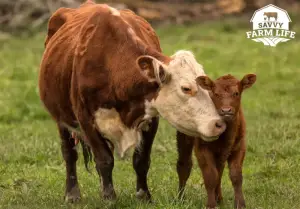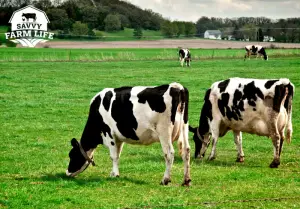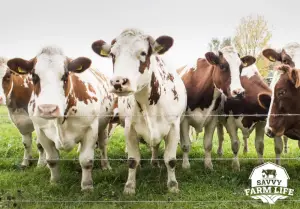The Difference Between Cow And Cattle
When driving through dairy country, are you watching the cows graze? Or are you watching the cattle graze? What is the difference? The distinction between these two words is confusing for many people, but is really quite simple once you learn a bit about bovine terminology (including what the word “bovine” means).
What is the difference between “cow” and “cattle”? In simple terms, “cow” is singular, while “cattle” is plural. A cow is specifically a female member of the bovine family who has given birth, while cattle can refer to a group of males, females, or a combination of both. In other words, multiple cows will always be referred to as cattle, but a single head of cattle is not necessarily a cow.
Between dairy farms and ranching, cattle is a huge industry with a lot of research, knowledge, and experience behind it. Read on for an overview of cattle terminology and the differences between different types of domesticated cattle.
Cow Or Cattle: Bovine Terminology
The cow is a member of the bovidae family, along with the buffalo, bison, antelope, and yak. Interestingly, there is no singular term for cattle in the English language that is not gendered – unlike the chicken, goat, horse, or sheep which can be a singular of either a male or female animal. How did this happen? Language is a funny thing, and no one can explain why we created singular non-gendered terms for every domesticated animal but the cow (or bull?).
When referring to a single member of a group of cattle then, one would need to know the sex in order to use the appropriate term. This may seem confusing, but no cattle rancher (or dairy farmer) will fault you for using the term “cow” when referring to a male member of the herd.
The only real exception here is when you hear a number of individuals described as “head” of cattle. A head of cattle is a single unit of the herd. If there are 32 bovine members in a herd, you would say there are “32 head of cattle”. However, this term is really only used to specify a number – you wouldn’t hear someone say “is that head over there a male or a female?”, for example.
Female Cattle (& Babies) 
Now that we understand a cow is specifically a female, we will need to go back a step further. While all cows are female cattle, not all female cattle are cows. A cow is a female who has given birth at least once. Before a cow has delivered offspring, she is called a heifer. Heifers who are destined for the breeding and/or dairy program may be safely bred between the ages of 12 and 14 months. If a heifer is not going to be bred, she will likely be used for beef.
There is an un-gendered singular term for baby cattle, and that is the calf. You will often hear the term “bull calf”, which is a male calf. Female calves are sometimes referred to as “heifer calves”. The age at which a calf is weaned will depend on the operation (with dairy calves “weaned” at just 24 hours of age), but the natural weaning age of a calf is around 10 months. Calves who have just been weaned are often referred to as “weaners”, while the term changes to “yearlings” once they have reached a year of age.
Male Cattle
Male cattle who have not been castrated and are at least 2 years of age are referred to as bulls. Bulls are the largest, strongest members of the herd and can reach a size of up to 2,000 pounds, depending on the breed.
Mature male cattle who have been castrated are referred to as steers. Most operations castrate their male calves between one and three months of age. Castration will somewhat affect the potential size of the steer, but will suppress much of the dominant and/or aggressive behavior that will often come with a bull. Steers dominate in the beef industry.
Cattle Domestication
Sheep and goats were the first domesticated livestock, but cattle closely followed, with the first long-horned domesticated cattle appearing around 8500 BC. What we now know as cattle came from the wild Auroch, which is now extinct. While not much is known about early domestication, evidence places the first domesticated cattle somewhere around Southwest Asia. Cattle migrated to Africa around 5000-4000 BC and to Britain around 2000-1000 BC. Around 3000 BC the first short-horned cattle showed up in Mesopotamia, and quickly became the dominant phenotype.
Before humans began selectively breeding, different climates and regions caused isolated herds to evolve and adapt into various “ecotypes”. In the 18th century, humans began developing various breeds of cattle through selective reproduction to enhance efficiency in specific industries. Today, there are hundreds of breeds used for dairy, beef, and agricultural work.
Beef Cattle
In terms of numbers, beef is the king of the cattle world. As of January 2022, there are over 30 million head of cattle used in the production of beef in the United States. Breeds of beef cattle will differ from successful breeds of dairy cattle, and are bred to put on both muscle and fat quickly.
Due to these traits, they will appear much stockier than a typical dairy cow. The most popular beef breeds are the Black and Red Angus, the Hereford, and the Texas Longhorn. These breeds have been tinkered with over the years to produce the most efficient beef for both large and small operations. Another difference between these two types of cattle is in milk production – most beef cows will produce just 2 gallons of milk per day, or just enough to feed their calves.
Steers are the most popular choice to raise for beef, particularly on smaller homesteads. Being larger than heifers, they give you the most amount of meat, but with a more agreeable temperament than that of a bull. The heifers with the best genetics will move on to the breeding program, while all others will be raised with the steers to be processed for beef.
Dairy Cattle 
While cattle raised for beef dominate the market in the US, dairy cattle are a formidable second, accounting for around ⅓ of cattle in the country. Dairy cattle will differ from beef cattle in that they appear thinner and the cows have much larger udders. You may see a perfectly healthy dairy cow and assume she is malnourished due to the prominent hip bones. In reality, most of the energy that a cow uses is concentrated into making more milk, and she is likely perfectly healthy and receiving adequate nutrition.
The most popular breed of dairy cattle is the Holstein – these are the white and black cattle that are most likely to adorn milk cartons and butter containers. The Holstein makes up 90% of the United States’ dairy cattle population. She can produce as much as 7-9 gallons of milk per day, having been bred over the years for the highest milk production.
Cows, of course, make up the bulk of a dairy herd, with bulls used for their semen (most dairy cows are artifiically inseminated rather than traditionally mated). One bull can service up to 40 cows, so there are far fewer male cattle needed for a dairy operation. Of course, a cow cannot produce milk without first birthing a calf – these calves are typically removed from the mother within 24 hours of birth.
Many of the heifer calves are raised with the intention of becoming dairy cows themselves, while many of the bull calves are considered “surplus calves”. Some bull calves are used for veal, while many are simply culled. There has been an emphasis in recent years on humane practices for dairy calves, and the UK in particular has implemented legislation to prohibit much of the culling of bull calves.
Unfortunately, there is not a large market for dairy-breed bull calves, and it is often far more economical to cull the bull calves than to raise them for such a limited market. This is a complex problem without an easy solution, and one that will likely continue to garner attention in the near future.
Cow: One Of The Most Misunderstood Terms In Agriculture
Now that you understand the specific meaning behind the word “cow”, it will be difficult to use it in the future outside of its proper context. After all, if you weren’t sure about the gender of a horse, you wouldn’t call the animal a “mare”, as it could just as likely be a male – you would simply call it a horse.
If you’re not sure about the sex of the animal, and you would like to reference it, just know that no one will fault you for using the word “cow” to describe what is actually a steer (or a heifer, for that matter). Until we add a new singular for cattle in the dictionary, there isn’t much of an alternative.

